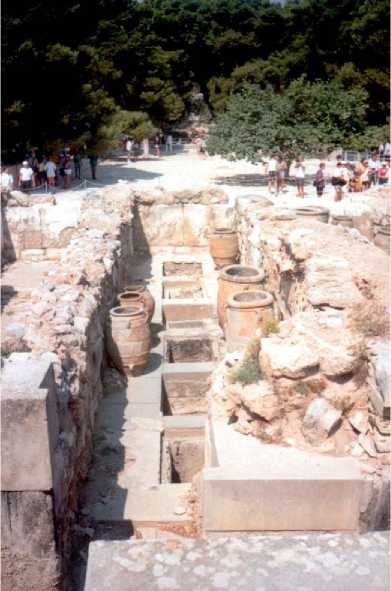Succinctly, linguistic studies of the Mycenaean language, the Linear B decrypted in 1952 by M. Ventris, proved it to be a sort of ancient Greek dialect, written by ideograms and syllabic symbols. It was the proof of a certain continuity between these civilizations and classical Greece, already suggested by the memory of a thalassocracy (Minoans) in the writings by Herodotus and Thucydides, as well as implied by the descriptions of the Iliad, by Homer (Mycenaeans) (see Classical Archaeology).
The chronology of Minoan civilization, whose name is obviously inspired by the legend of the Cretan king Minos and the Minotaurus, is comprised between 2100 and 1450 BCE and several archaeological remains can be found especially in Crete, since the discovery of Knossos by Sir A. Evans at the beginning of twentieth century. Some important palaces in the best-known cities such as Knossos, Phaistos, Malia, and Zakros characterized this civilization, whose language, the Linear A, is still to be deciphered.
Archaeological research has interpreted these buildings, constructed in the form of a courtyard with several rooms around it, as a palace having various functions such as habitation, administration and official ceremonies, and also religious functions. Some cases include stocking facilities, which indicate a commercial function as well (Figure 2). All these elements, together with the analysis of the evolution of architectural remains, allow the statement of a civilization with a growing degree of centralization, attaining an impressive measure in the apogee of Minoan times between 1700 and 1450 BCE. During this time, we can hardly distinguish the main palace and the urban quarters, becoming a large and intricate net of constructions. Recent research has indicated important commercial routes in the basis of ceramic material found in surveys and excavations, with a growing precision of its typology, chronology, and origin of production.
Mycenaean civilization developed from 1700 and, during the period from 1450 to 1300 BCE, archaeological research has discovered remains of a series of important damages suffered by the great Minoan palace at Knossos. Recent developments have supported the hypothesis of linking the development of Mycenaeans (with an increasing number of remains found in Crete, as well as a large quantity of ceramic

Figure 2 Knossos, Crete: the warehouse with pithoi on the ground (Minoan period).
And the presence of written tablets in Linear B), and the series of destructions suffered by Knossos.
Mycenaean is the name given by H. Schliemann to those he thought to be the people described by Homer in the Iliad. At the edge between antiquarianism and scientific archaeological research, the discovery of the so-called Agamemnon mask, a golden mask H. Schliemann attributed to the Mycenaean king and chief of the Greek expedition to Troy, was used as the proof of the existence of that civilization. If there is still much discussion about the association of the literary tradition in the Homeric epic poems and the Mycenaean culture, ulterior research has proved at least the existence of a kind of common culture, in the forms of funerary rituals and the geographical spread of ceramics. The other great discovery by H. Schliemann was the location of the city of Troy (Figure 3), which has been excavated by a join American-German team (since 1988) and became a Turkish national historical park in 1996. The geographical spread of this civilization was impressive, reaching most of mainland Greece, several islands of the Cyclades, Crete, and Asia Minor, which can be verified by the similarities of funerary customs as well as by the spread of a common type of ceramics. Despite this large territory, we only know four palaces of that period: Mycenae, Tiryns, Pylos, and Thebes. Most of what we know of Mycenaean civilization comes either from archaeological research in these palaces, which seem to concentrate all the administration of the city, or, on the other hand, by the interpretation of epigraphic evidence, mostly in the form of clay tablets in Linear B.
Several elements described in Homer’s epics, notably in the Iliad, found a correspondent in some archaeological findings (like a cup similar to the Nestor’s cup, weapons whose techniques of production coincide with the descriptions by Homer, etc.), posing a problem of chronology. Recent research has proved that Homer’s descriptions are not perfectly Mycenaean, but a mixture of elements of a long past memory and his contemporary society, of the eighth century BCE: one example is that weapons in the Iliad are described as iron ones although those of the Myce-naeans were in bronze.




 World History
World History









